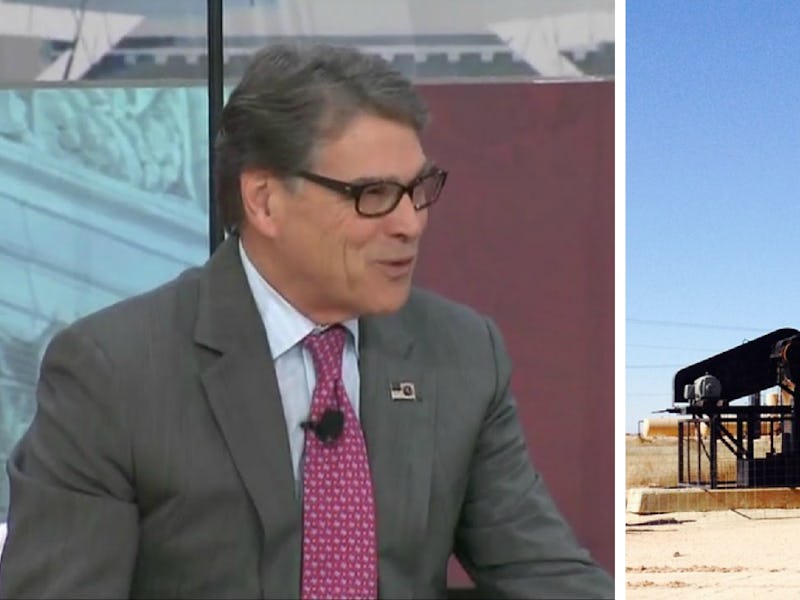At CPAC, Rick Perry Avoids Divulging How Much Oil America Has Left
But experts can give an exact figure.

Early Friday morning at the Conservative Political Action Conference, Secretary of Energy Rick Perry and Secretary of the Interior Ryan Zinke brought up former President Jimmy Carter and the 1970s energy crisis. Interviewer and former Congressman Bob Beauprez grilled Perry on what had changed in the United States since Carter told the nation in 1977 that oil and natural gas reserves were running out, ultimately asking the big question: How much energy and gas do we really have left?
“To ever draw that line and say, ‘This is what we know and there is nothing left to know’ is a big mistake,” Perry responded cautiously, avoiding definitive statements, unlike Carter. “The difference between Jimmy Carter mentalities and the current place we find ourself in, the Trump administration mentality, is the difference between regulation and innovation.”
Commentary on regulation aside, Perry is correct that innovation has been the key to the United States’ booming success in oil and gas. There’s no threat, like Carter predicted, that the United States is going to run out of those energy sources in the near future.
Perry, Zinke, and Beauprez at CPAC.
As of February 2017, there are 900,000 active oil and gas wells and more than 130,000 of them were established after 2010. Technological advances, like fracking, have given the private sector unprecedented access to oil and gas resources in layers of shale rock. Fracking, which involves hydraulic fracturing and horizontal drilling, allows energy sources to be extracted more efficiently and has put the U.S. in route to surpass Saudi Arabia as the world’s leader in oil output.
But the question remains: How much oil and gas does the U.S. have? As of 2018, the U.S. output is estimated at over 10 million barrels of oil a day. According to Rystad Energy, an independent oil and gas consulting service, the U.S. has approximately 246 billion barrels of oil reserves. This estimate is based on data from existing oil fields, newly discovered reserves, and the probability of finding reserves in geological areas.
U.S. shale basins, as of 2011.
The number of proven reserves — the ratio of the quantity of oil that can be produced to the actual rate of production — is 35.3 billion barrels, according to the U.S. Energy Information Administration. In 2015, Texas and Oklahoma, where fracking is prevalent, experienced the largest net increases in proved reserves of crude oil.
Access to shale formations has also driven an increase in natural gas collection. According to the EIA, the U.S. proved reserves of crude oil, lease condensate, and total natural gas has increased by more than 50 percent in the last decade. Before natural gas was found within the Barnett Shale in Texas, reserves had been on the decline since the 1970s. As of 2015, the U.S. had an estimated 2,355 trillion cubic feet of technically recoverable resources of dry natural gas, enough to last the country 86 years.
But according to the EIA, “the actual number of years will depend on the amount of natural gas consumed each year, natural gas imports and exports, and additions to natural gas reserves.” In 2016, the U.S. consumed an estimated 27.49 trillion cubic feet of natural gas.
2013 map of natural gas extraction by countries in cubic meters per year.
Whether or not we should be continuing the use of natural gas and oil, despite their accessibility, is another question. Natural gas emits 50 to 60 percent less carbon dioxide when combusted in a natural gas power plant compared to a coal plant, but the process of drilling and extraction pumps sulfur, mercury, and particulates into the air. The burning of fossil fuels, like oil, is directly linked to the progression of climate change. According to the EPA, the burning of fossil fuels was responsible for 79 percent of U.S. greenhouse emissions in 2010.
At CPAC, Perry asserted that “freedom is being exported around the world through American energy” and that, if we give incentive to innovators, “they’ll find the answers to the challenges we face as a humanity.” What he did not discuss was how the innovators who have helped us access oil and gas will, in turn, help us recover from the damage of those sources to the environment.